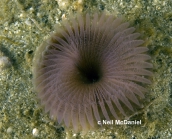
| Intro | | Search taxa | | Browse taxa | | Distributions | | Terminology | | References | | Statistics | | Online sources | | Tutorial | | Log in |
CaRMS taxon detailsMyxicola Koch in Renier in Meneghini, 1847
129537 (urn:lsid:marinespecies.org:taxname:129537)
accepted
Genus
marine,
recent only
neuter
Renier, Stefano Andrea [posthumously as edited by Meneghini, Guiseppe]. (1847). Osservazioni postume di Zoologia Adriatica del Professore Stefano Andrea Renier, membro effettivo dell'Istituto Italiano, pubblicate per cura dell'I. R. Istituto Veneto de Scienze, Lettere ed Arti a studio del membro
effettivo Prof. G. Meneghini. pp. ix, (1), 120, (2), 16 plates. Giovanni Cecchini, Venezia.
page(s): 52 ; note: based on a Koch MS fide Nomenclator Zoologicus & Grube 1855 [details]
Read, G.; Fauchald, K. (Ed.) (2025). World Polychaeta Database. Myxicola Koch in Renier in Meneghini, 1847. Accessed through: Nozères, C., Kennedy, M.K. (Eds.) (2025) Canadian Register of Marine Species at: https://www.marinespecies.org/Carms/aphia.php?p=taxdetails&id=129537 on 2025-05-08
Nozères, C., Kennedy, M.K. (Eds.) (2025). Canadian Register of Marine Species. Myxicola Koch in Renier in Meneghini, 1847. Accessed at: https://www.marinespecies.org/CaRMS/aphia.php?p=taxdetails&id=129537 on 2025-05-08
Date action by
original description
Renier, Stefano Andrea [posthumously as edited by Meneghini, Guiseppe]. (1847). Osservazioni postume di Zoologia Adriatica del Professore Stefano Andrea Renier, membro effettivo dell'Istituto Italiano, pubblicate per cura dell'I. R. Istituto Veneto de Scienze, Lettere ed Arti a studio del membro
effettivo Prof. G. Meneghini. pp. ix, (1), 120, (2), 16 plates. Giovanni Cecchini, Venezia.
page(s): 52 ; note: based on a Koch MS fide Nomenclator Zoologicus & Grube 1855 [details] taxonomy source Tilic, Ekin; Sayyari, Erfan; Stiller, Josefin; Mirarab, Siavash; Rouse, Greg W. (2020). More is needed—Thousands of loci are required to elucidate the relationships of the 'flowers of the sea' (Sabellida, Annelida). <em>Molecular Phylogenetics and Evolution.</em> 151: 106892: 1-9., available online at https://www.sciencedirect.com/science/article/pii/S1055790320301640 page(s): 7 of 9; note: Moved to a new classification in tribe Myxicolini of subfamily Myxicolinae [details] Available for editors taxonomy source Putignano, Matteo; Langeneck, Joachim; Giangrande, Adriana. (2024). The forgotten diversity of the genus <i>Myxicola</i> (Polychaeta: Sabellidae) in North America: redescription of historical taxa and description of two new species. <em>Journal of Natural History.</em> 58(37-40): 1393-1427., available online at https://www.tandfonline.com/doi/full/10.1080/00222933.2024.2370664 [details] taxonomy source Claparède, Édouard. (1869). Les Annélides Chétopodes du Golfe de Naples. Seconde partie. Ordre II<sup>me</sup>. Annélides Sédentaires (Aud. et Edw.). <em>Mémoires de la Société de Physique et d'Histoire Naturelle de Genève.</em> 20(1): 1-225, plates XVII-XXXI., available online at https://biodiversitylibrary.org/page/14264110 page(s): 140-141; note: emendation of Myxicola diagnosis, synonymy of "Myxicola infundibulum" [details] additional source Fauchald, K. (1977). The polychaete worms, definitions and keys to the orders, families and genera. <em>Natural History Museum of Los Angeles County: Los Angeles, CA (USA), Science Series.</em> 28:1-188., available online at http://www.vliz.be/imisdocs/publications/123110.pdf [details] additional source Bellan, G. (2001). Polychaeta, <i>in</i>: Costello, M.J. <i>et al.</i> (Ed.) (2001). European register of marine species: a check-list of the marine species in Europe and a bibliography of guides to their identification. <em>Collection Patrimoines Naturels.</em> 50: 214-231. (look up in IMIS) [details] additional source Muir, Alexander I.; Petersen, Mary E. (2013). Authorship of some polychaete (Annelida) names derived from the works of Renier and Savigny. <em>Zootaxa.</em> 3717(3): 383., available online at https://doi.org/10.11646/zootaxa.3717.3.8 note: discusses nomenclatural issues [details] Available for editors redescription Grube, Adolph Eduard. (1855). Beschreibungen neuer oder wenig bekannter Anneliden. <em>Archiv für Naturgeschichte, Berlin.</em> 21(1): 81-136, plates III-V., available online at https://biodiversitylibrary.org/page/6651100 page(s): 121-122; note: attributes authorship to Koch in Renier [details]  Present Present  Inaccurate Inaccurate  Introduced: alien Introduced: alien  Containing type locality Containing type locality
From editor or global species database
Authority Grube (1855: 121) assigns the authorship just to Koch, but this evidently is Koch as published in Renier, 1847, p.52. Neave assigns the authority to Renier, 1847 (actually to Meneghini, the editor of Renier), but with the note "(Koch MS)" [details]Editor's comment The Myxicola type species has been assumed to be Terebella infundibulum Renier [1804] by subsequent designation (e.g. Hartman catalogue p.551), but this name is unpublished (ICZN Opinion 316) until 1847. Renier (1847) is reported to have used it again, but in the same publication that named Myxicola. Combined in Myxicola, as noted by Muir & Petersen (2013) it is junior to Amphitrite infundibulum Montagu, 1808 if they represent the same species, and also a junior secondary homonym (both presumably named for the funnel-like appearance of the crown). Further clarification of these issues seems necessary. [details] |
![Original plate of Amphitrite infundibulum [now Myxicola infundibulum] Original plate of Amphitrite infundibulum [now Myxicola infundibulum]](https://images.marinespecies.org/thumbs/129309_original-plate-of-amphitrite-infundibulum-now-myxicola-infundibulum.jpg?w=150)


